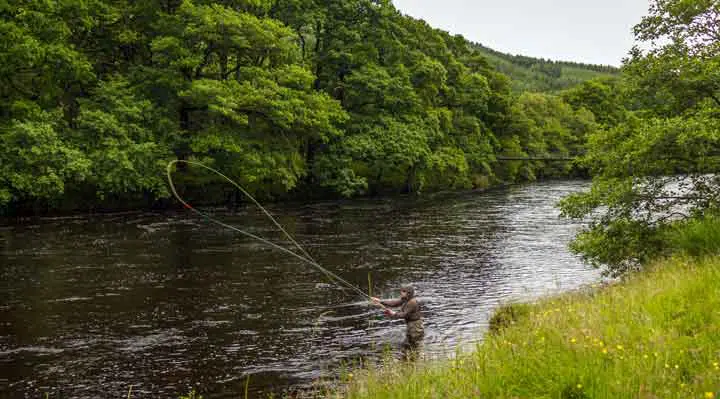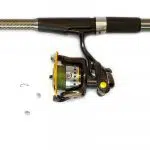Of all outdoor enthusiasts, anglers, whether by nature or circumstance, are creatures of habit. That leads to strong opinions and debates about equipment, strategies, and tactics. One of the more spirited debates among fishers is whether a braided or monofilament (braid vs mono) fishing line is better.
Both have their fans, detractors, and those who are indifferent. The following is an in-depth analysis of the positives and negatives of both braided and mono fishing line.
What is Better, Braided Line or Mono?
There is no better option between braided or mono line. Both fishing lines have pros and cons. Each also has fishers devoted to their preferred type of fishing line. In many cases, why someone likes braided line over mono comes down to personal preference.
For example, some anglers like braided line because of the fishing line strength. At the same time, many anglers like mono because it is less expensive and difficult to see in the water. Each of those reasons is a legitimate justification for their preference.
What is the Advantage of Braided Fishing Line?
Braid fishing line has several advantages like easier casting, a higher test line and no stretch.
Easier Casting
Braid tends to cast further because it “unfolds” more smoothly and has a coat with a polymer that helps reduce friction on a line as it unfurls through the eyelets on the rod. In good weather, the difference in casting smoothness is hardly noticeable with most anglers. In windy weather, however, the polymer coating can make a big difference.
Braided line is also an immense aid to anglers with hand issues, such as an injury, disease that affects hand mobility, or arthritis. It helps in at least two ways:
- The line casts further with less effort on the part of the angler
- The polymer coating prevents tangling, which someone with hand issues could not easily untangle

Higher Test Line
Another benefit of braid is being able to fish higher pound tests on tested reels and rated to handle specific poundage of mono. Thus, you can fish for larger fish, using less line with braid.
For example, if you have a reel rated to spool 100 yards at 10 lb-test mono, you can put a higher pound test line on the reel at roughly equivalent space requirements. You could string the reel with 100 yards of 30 lb-test braid and be able to handle a much larger fish.
Braided line also holds up better when a lure gets snagged. It is easier to pull out of a snag because the strength of the line is significantly more than a similar amount of mono. In a body of water with submerged structure or snag-hazards from broken and fallen timber, a stronger fishing line means fewer lures get lost.
No Memory or Stretch
Braid has little to no “spool memory.” Spool memory is when the line takes the form of the spool. Mono has a lot of spool memory. It can lead to tangling as well as knots from yanking on the tangle.
Braided line has no memory, which means that the stress you put on it short of fraying the line is gone once you stop stressing it.
The reason the braided line has no memory is partly due to the previously mentioned polymers, plus the fact that a braided line has no “stretch.” That means when stressed, the strength of the line is static and does not have any give. The lack of flexibility prevents the line from conforming to the shape of the spool because it does not recede once at rest the way mono does.
A downside to lack of stretch is that there is no play in the line once it is taut. That can result in oversetting of hooks, which can rip a hook from a fish’s mouth or snap the line.
To compensate for line rigidity, anglers must adjust their drag when setting a hook. A more open drag allows a hook to be set with more force while not injuring the fish.
The lack of stretch also helps reveal the bottom of a body of water very clearly. It lets the angler “see” what is underneath and feel just about every dip, structure, rock, or bump. That also translates into feeling even the slightest bites, which can translate into landing more fish.
What are Braided Line Cons?
There main cons about braided line are the knot weakness and the visibility of the line.
Knot Weaknesses
Tied correctly, any knot used with a braided line is strong enough for most challenges an angler will encounter. If, however, you cinch or tie a knot incorrectly, it can be a weak spot that comes undone when exposed to a lot of stress.
Visibility
A braided line is visible, even in murky water. In clear water, if fish are being picky, braid lines can be a deal killer.
No Stretch can be a Shock
A line that does not stretch can part when a fish bolts with your lure, it also is very hard on your hardware because there is no give. Using braid means you must understand how to use your drag.
Not having any stretch can also be a safety hazard. If your finger gets caught in a line when you hook a large fish, the line will not snap as easily as mono, which can lead to serious injury. In worst-case scenarios, it can even sever a finger.
Why is Braided Line Banned?
Most fisheries don’t ban using braided line. Some fisheries or piers, however, have banned using braided line because of abuse by some anglers.
Braided line is often fished at a much higher lb-test and that has led anglers to force fish through weeds and snags rather than working them through patiently. The yanking has led to fish injury and even death from the stress, puncture wounds, and breaking their jaws.
Another problem is that braided line does not part evenly all the time. In some cases, if the line extends a lot, there can be several yards between the parting of the first line in a braid and the point that the last line in the braid severs.
When braided line breaks like that, you can leave long strands in a fishery. Because it does not naturally degrade, that line can pose a risk to other animals. Fish, turtles, waterfowl, and water-oriented mammals like beavers, otters, and muskrats all can become ensnared and wrapped in underwater lines.
Mono fishing line poses the same risk, but most breaks occur fairly close to the snag, or at the knot. That means there is a lot less line that gets left underwater.
To address these issues, some fisheries have restricted the use of braid or banned its use outright.
What is the Advantage of Mono Fishing Line?
Mono fishing line has the visibility of the line, a stretch that helps and a more economic price to their advantages.
Visibility
Mono is invisible, or at least, very difficult to see. In water that is cloudy, muddy, green, or has a lot of debris, it is almost impossible to see it attached to a lure. It also tends to blend in better than braid because most fish see in a yellow tint.
With fish that have decent eyesight or are tentative, that can be a game-changer.
Stretch Can Help
While line stretch can be a headache when a lint tangles, it can play an important role when landing a fish. There are a few benefits to line stretch:
- You can set hooks easier with little fear of oversetting
- A running fish will not snap a line as easily
- A snagged line will give and in many cases, that can loosen a hook
Cost
Braided lines are expensive. Mono lines are not. You can get a quality mono line for a fraction of the cost of an average quality braided line.
What are the Cons of Mono?
The main cons of the mono line are its tangle, the durability of the line and it’s memory.
Tangle
The most significant drawback to mono is the tangle that can ensue as you use the line. This is a product of using mono on a spinning reel mostly, but tangle can even be an issue with mono on a bait caster.
Memory
Tangle can also be the result of line memory, which mono almost always has. Line memory on the spool leads to a line that is prone to fold over itself when not held taut. That leads to unwanted tangling and knots.
Durability
Mono tends to weaken with time quicker than braid. A line left alone over winter can go bad, particularly if exposed to moisture. It also will stretch over time and use, which can cause weak spots. Additionally, using mono in bodies of water with rocks, trees, and other structures can lead to fraying and nicks, which when you apply a lot of pressure can part.
Does Braid or Mono Cast Further?
This also is variable. If all things are equal and a braided line is cast on a bait caster, it will tend to go farther. On a spinning rod, though, mono can be cast further under proper conditions. Because distance is not usually a key to successful fishing, however, the line cast length is not a factor.
Which is Better: Braid vs Mono?
As mentioned earlier, it depends. If you are casting a lot over a long distance, braid wins out. Safety-wise, braided lines can pose dangers to fingers. Fish can see braid easier, but mono comes with a lot of tangles. Braid is significantly more expensive.
So which wins? The reality is both have pros and cons. You should base what you use on what you are comfortable with, taking the fishing situation you are encountering into account. Understanding all your options with mono or braided line is key.




